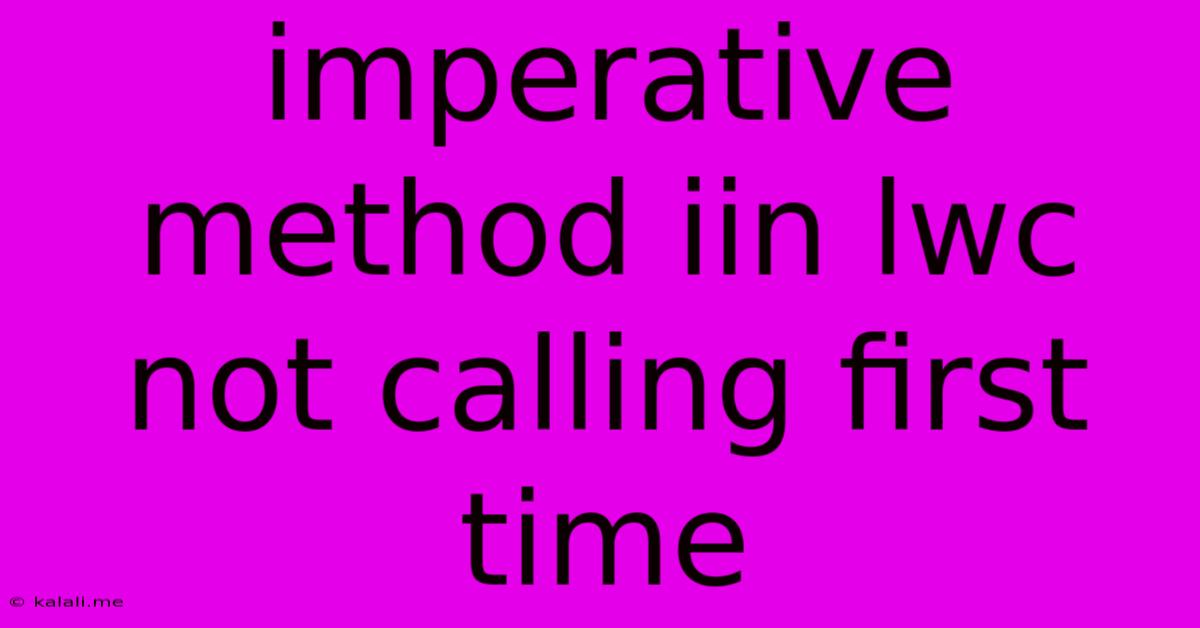Imperative Method Iin Lwc Not Calling First Time
Kalali
May 23, 2025 · 4 min read

Table of Contents
Why Your Imperative Method in LWC Isn't Calling on First Render: Troubleshooting and Solutions
This article tackles a common frustration for Lightning Web Component (LWC) developers: imperative methods not executing on the initial render. We'll explore the reasons behind this behavior and provide practical solutions to ensure your methods fire as expected. Understanding this crucial aspect is key to building robust and functional LWC components.
Understanding the LWC Lifecycle: Before diving into solutions, it's crucial to understand the LWC lifecycle. When a component renders, it goes through a series of stages, including rendering the template, executing connectedCallback, and then renderedCallback. Imperative methods often rely on these lifecycle hooks to execute correctly. Misunderstanding this sequence frequently leads to methods not firing as intended.
Common Causes and Debugging Strategies:
There are several reasons why your imperative method might not be called the first time your LWC renders:
-
Incorrect Lifecycle Hook: The most common mistake is placing the method call in the wrong lifecycle hook. While
renderedCallbackmight seem like the obvious choice, it's often better to handle imperative method calls withinconnectedCallback.renderedCallbackonly fires after the component's initial render, and sometimes initialization logic within imperative methods relies on data being available, which may not happen until after the first render is completed. -
Asynchronous Operations: If your method relies on asynchronous operations (like fetching data from an Apex controller or external API), it might not complete before the initial render finishes. This can result in the method seemingly not executing. You need to ensure that you’re handling promises and asynchronous operations within the lifecycle hook correctly, perhaps using
awaitor.then()to handle the asynchronous results. -
Conditional Logic Issues: Your method call might be wrapped in conditional logic that's not evaluating to true during the initial render. Double-check your conditional statements to ensure they're correct and your data is available at the appropriate time. Check the values of your variables using
console.log()to help debug. -
JavaScript Errors: Unhandled JavaScript errors within your component can prevent the execution of subsequent code, including your imperative method. Use the browser's developer tools to check for errors in the console; this is an often overlooked aspect of debugging.
-
Data Dependency Issues: Your imperative method might depend on data that isn't yet available when the component first renders. Ensure that the data is properly loaded and assigned before calling your method. This can often be a problem if you are using @wire or another similar method for data loading.
Solutions and Best Practices:
Here's how you can address these issues:
-
Use
connectedCallback: Prefer usingconnectedCallbackfor imperative method calls that depend on the component being fully connected to the DOM. This lifecycle hook happens reliably before the rendering, reducing the risk of race conditions. -
Handle Asynchronous Operations: Use
async/awaitor promises to manage asynchronous tasks. Ensure your method waits for the completion of these tasks before executing the rest of its logic. -
Debug with
console.log(): Useconsole.log()strategically to inspect the values of variables and the execution flow of your code. This helps identify problems within conditional logic and data dependencies. -
Check for JavaScript Errors: Regularly examine the browser's developer console for any JavaScript errors that might be blocking your method's execution.
-
Ensure Data Availability: Verify your data is ready before calling the imperative method. If you're using
@wire, make sure the data is properly passed to your method after the@wiredecorator has completed. -
Use the
renderedCallbackjudiciously: While often tempting, avoid overly relying onrenderedCallbackfor essential initializations. It's typically best suited for operations that need to happen only after the component's structure has been fully rendered.
Example:
Let's assume you have an imperative method fetchData() that fetches data asynchronously:
import { LightningElement, api, wire } from 'lwc';
export default class MyComponent extends LightningElement {
@api recordId;
data;
connectedCallback() {
this.fetchData();
}
async fetchData() {
//Simulate fetching data; Replace with your actual data fetching logic
try {
const response = await new Promise(resolve => setTimeout(() => resolve({name: 'John Doe'}), 1000));
this.data = response;
} catch (error) {
console.error('Error fetching data:', error);
}
}
}
By following these strategies and best practices, you can confidently ensure your imperative methods are called correctly within your LWC components and avoid common pitfalls related to the LWC lifecycle. Remember that consistent debugging and a clear understanding of the lifecycle are essential for building reliable and performant LWC applications.
Latest Posts
Latest Posts
-
Where Is The 3 In Riddle Transfer
Jul 03, 2025
-
How Much Does A Water Bottle Weight
Jul 03, 2025
-
How Many Inches Is Half A Yard
Jul 03, 2025
-
How Old Are You If Your Born In 1996
Jul 03, 2025
-
How Many Water Bottles In 64 Ounces
Jul 03, 2025
Related Post
Thank you for visiting our website which covers about Imperative Method Iin Lwc Not Calling First Time . We hope the information provided has been useful to you. Feel free to contact us if you have any questions or need further assistance. See you next time and don't miss to bookmark.